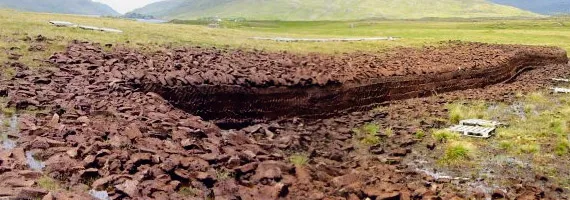There are many different types and qualities of high peat available. The characteristics of peat depend among other things on the depth from which it is extracted, the method of extraction and climatic circumstances in the peat region. Working through the peat profile from the top down we will find the following types:

'Upper layer' of peat
The ‘upper layer’ is the top feet of the peat profile. According to German peat cutting regulations this layer should be laid on the sandy bed after the white and black peat have been dug out. When this was changed to agricultural land this remaining peat is deeply ploughed into the sandy bed to mix it. At present, permission may well be given to use the ‘upper layer’ of peat in potting mix. A disadvantage of the ‘upper layer’ of peat is that it does not always have a homogeneous composition.
Sphagnum moss peat
Sphagnum moss peat is young, partially decomposed sphagnum moss that can retain between 10 to 12 times its own weight in water. It has a light colour and is made up almost entirely of different types of sphagnum moss. Because sphagnum moss peat is a relatively young organic material, it breaks down more quickly than older types of peat. Originating in Northern Europe sphagnum moss peat is mainly used in the expensive sorts of potting mix at present.

Peat litter
Peat litter or peat dust is extracted from the top layer of the peat profile. The product is light brown and only slightly decomposed. Peat litter can retain at least 8 times its own weight in water. Water uptake and release are slower processes than in sphagnum moss peat. Peat litter is available as fine, normal and coarse the grade depending on the method used for extraction.
The fine grade is extracted horizontally with the peat being cut out layer by layer and then dried and harvested. This is easily the cheapest method. In order to produce a larger coarse grade, the more expensive vertical pitch method of extraction has to be used.
Black peat (non permafrost)
Non permafrost black peat, which is also known as old peat, champ peat or casing soil peat, is not suitable for potting mix because it shrinks a lot when it dries and thereafter has low water retention levels. If it is thoroughly dried it becomes very hard peat (pressed peat) that can be used as fuel.

Garden peat
Garden peat is an important source for the potting mix industry. It is produced by allowing wet black peat to freeze. The quality of the garden peat depends on the extent to which it has been frozen. Freezing black peat improves its water retention qualities and reduces shrinkage. After drying garden peat can take up at least 4 times its own weight in water. Garden peat is dark brown, which is a good indication that it has already reached an advanced stage of decomposition. It consists of very fine particles, which gives it a relatively low air content.
‘Coloured’ peat
‘Coloured’ peat is extracted from the layer between the white and black peat layers. This layer has decomposed further than the white layer and its colour lies between the white and black peat. ‘Coloured’ peat can retain less water than peat litter and sphagnum moss peat.









